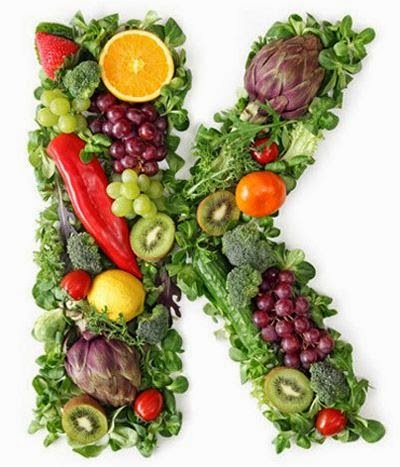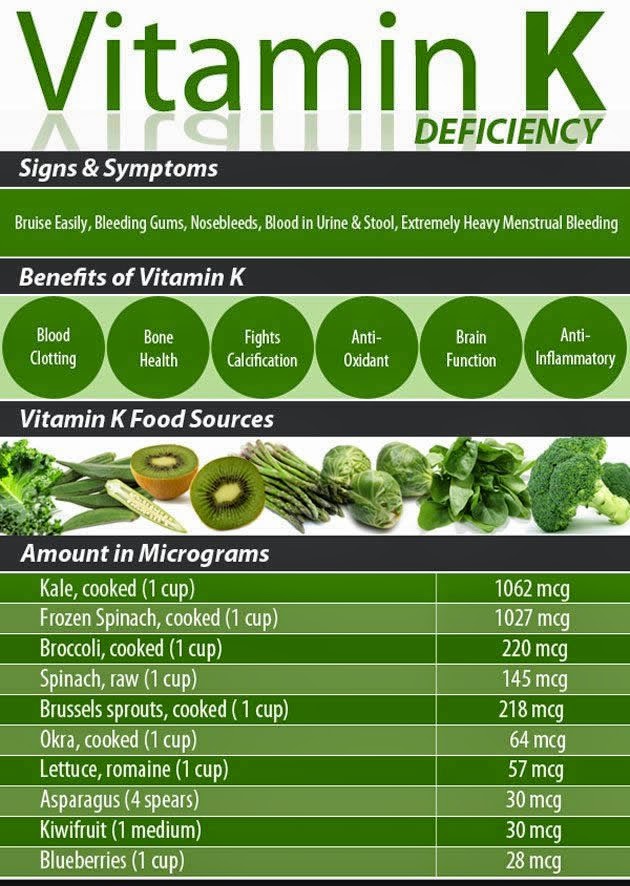 |
| Vitamin K |
Vitamin K originates from the German term koajulation. It is also known as antihemorrhagic factor, and is one of the four fat-soluble vitamins necessary for good health.
The others are vitamins A, D, and E. The primary and best-known purpose of vitamin K is support of the process of blood clotting. Prothrombin and other clotting factors are dependent on vitamin K for production.
It also plays a role in bone health, and may help to prevent
osteoporosis. Appropriate growth and development are supported by adequate vitamin K.
There are several forms of the vitamin:
- K1 or phylloquinone; also known as phytonadione
- K2, a family of substances called menaquinones
- K3 or menadione, a synthetic form of this vitamin
General use The Required Daily Amount (RDA) of vitamin K is 5 micrograms (mcg) for infants less than six months old, 10 mcg for babies six months to one year old, 15 mcg for children aged one to three years, 20 mcg for those aged four to six years, and 30 mcg for those seven to ten years old.
Males require 45 mcg from 11–14 years, 65 mcg from 15–18 years, 70 mcg from 19–24 years, and 80 mcg after the age of 24 years. Females need 45 mcg from 11–14 years, 55 mcg from 15–18 years, 60 mcg from 19–24 years, and 65 mcg after the age of 24, and for
pregnant or lactating women. These values are based on an estimate of 1 mcg of vitamin K per kilogram of body weight.
The most common use of vitamin K is to supplement babies at birth, thus preventing hemorrhagic disease of the newborn. Routine administration of vitamin K to newborns is, however, being questioned by practitioners of evidence-based nursing.
In 2003 the American Academy of Pediatrics (AAP) restated that prevention of bleeding from early vitamin K deficiency by administration of the vitamin is accepted practice. The AAP also noted that a possible link between supplemental vitamin K and early childhood cancer has not been proven as of 2003.
Others who may benefit from supplemental vitamin K include those taking medications that interact with it or deplete the supply. It also appears to have some effectiveness in preventing osteoporosis, but some studies done involved patients using a high dietary intake of the vitamin rather than supplements.
 |
| Source of vitamin K |
In 2003, however, a group of Japanese researchers reported that supplemental doses of vitamin K2 given together with vitamin D3 appeared to reduce bone turnover and sustain bone density in postmenopausal women with mild osteoporosis.
People taking warfarin, a vitamin K antagonist, are able to use the vitamin as an antidote if the serum level of warfarin is too high, increasing the risk of
hemorrhage
. Vitamin K taken by mouth appears to be more effective than intramuscular injections of the vitamin when it is used to counteract the effects of warfarin.
Vitamin K is also used to treat bleeding from the esophagus and other complications of cirrhosis, a disease of the liver.
Some women find that supplemental vitamin K relieves the symptoms of morning sickness during pregnancy. This treatment is even more effective if vitamin K is taken together with vitamin C.
Topical formulations of vitamin K are sometimes touted as being able to reduce spider veins on the face and legs.
The creams are quite expensive and the efficacy is questionable at best. However, recent clinical studies have shown that topical applications of vitamin K given to patients following laser treatments on the face are effective in minimizing bruising from the procedure.
More recently, researchers have been studying vitamin K intensively for its potential anticancer effects. Vitamin K
3 in particular may be useful as an adjuvant treatment for
ovarian cancer
.
Preparations Natural sources Dark green leafy vegetables are among the best food sources of vitamin K in the form of K
1.
Seaweed is packed with it, and beef liver, cauliflower, eggs, and strawberries are rich sources as well.
Vitamin K is fairly heat-stable, but gentle cooking preserves the content of other
nutrients that are prone to breaking down when heated. Some of the supply for the body is synthesized as vitamin K
2 by the good bacteria in the intestines.
Supplemental sources Vitamin K is not normally included in daily multivitamins, as deficiency is rare. Oral, topical, and injectable forms are available, but should not be used except under the supervision of a health care provider.
Injectable forms are by prescription only. Supplements are generally given in the form of phytonadione since it is the most effective form and has a lower risk of toxicity than other types. Synthetic forms of vitamin K are also available for supplemental use.
Deficiency Deficiency of vitamin K is uncommon in the general
population but is of particular concern in neonates, who are born with low levels of vitamin K.
Hemorrhagic disease of the newborn can affect infants who do not receive some form of vitamin K at birth. Affected babies tend to have prolonged and excessive bleeding following circumcision or blood draws. In the most serious cases, bleeding into the brain may occur.
Most commonly an injection of vitamin K is given in the nursery following birth, but a series of oral doses is also occasionally used. The primary sign of a deficiency at any age is bleeding, and poor
growth may also be observed in children.
Chronically low levels of vitamin K are correlated with higher risk of hip fracture in older men and women. A study done in 2003 reported that the current recommended dietary intake for vitamin K in adults may not be adequate for older women.
 |
| Vitamin K Deficiencies |
Risk factors for deficiency Vitamin K deficiency is unusual, but may occur in certain populations, including those on the medications mentioned in interactions, alcoholics, and
people with diseases of the gastrointestinal tract that impair absorption. Conditions that may be problematic include
Crohn’s disease
, chronic diarrhea, sprue, and ulcerative colitis.
Anything that impairs fat absorption also risks decreasing the absorption of the fat-soluble vitamins. Long term use of broad spectrum antibiotics destroys the bacteria in the intestinal tract that are necessary for the body’s production of vitamin K.
Precautions Allergic reactions to vitamin K supplements can occur, although they are rare. Symptoms may include flushed skin, nausea, rash, and itching. Medical attention should be sought if any of these symptoms occur.
Infants receiving vitamin K injections occasionally suffer hemolytic
anemia or high bilirubin levels, noticeable from the yellow cast of the skin.
Emergency medical treatment
is needed for these babies. Liver and brain impairment are possible in severe cases.
Certain types of liver problems necessitate very cautious use of some forms of vitamin K. Menadiol sodium diphosphate, a synthetic form also known as vitamin K
4, may cause problems in people with biliary fistula or obstructive jaundice. A particular metabolic disease called G6-PD deficiency also calls for careful use of vitamin K
4.
The expertise of a health care professional is called for under these circumstances.
Sheldon Saul Hendler, MD, PhD
, advises there is no reason to supplement with more than 100 mcg daily except in cases of frank vitamin K deficiency.
Side effects Oral forms of vitamin K
4 may occasionally irritate the gastrointestinal tract. High doses greater than 500 mcg daily have been reported to cause some allergic-type reactions, such as skin rashes, itching, and flushing.
Interactions There are numerous medications that can interfere with the proper absorption or function of vitamin K. The long-term use of antacids may decrease the efficacy of the vitamin, as can certain anticoagulants. Warfarin is an anticoagulant that antagonizes vitamin K. Efficacy of the vitamin is also decreased by dactinomycin and sucralfate.
Absorption is decreased by cholestyramine and colestipol, which are drugs used to lower blood cholesterol levels. Other drugs that may cause a deficiency include long-term use of mineral oil, quinidine, and sulfa drugs. Primaquine increases the risk of side effects from taking supplements.
Other types of prescription medications that may cause vitamin K depletion include
anticonvulsants (drugs to prevent seizures)
, including valproic acid; macrolide, aminoglycoside, cephalosporin, and fluoroquinolone antibiotics; phenobarbital; and dapsone (used to treat leprosy and skin infections).
























